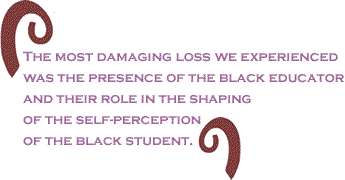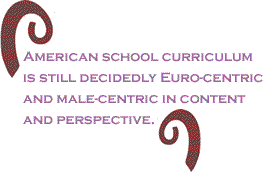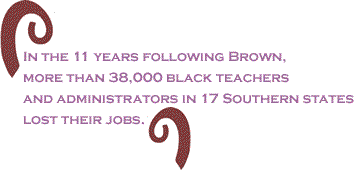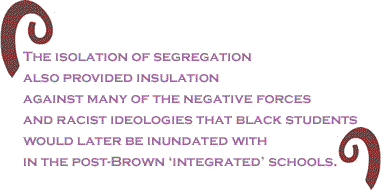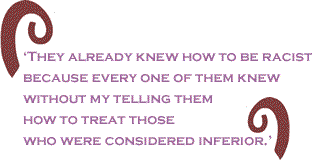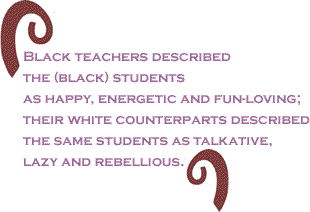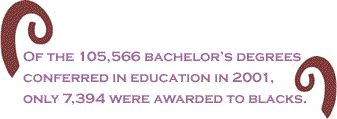
|
|||||||||||||||||||||
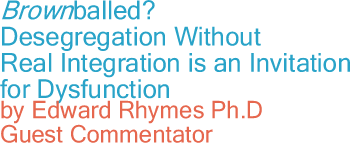 |
In the education of our children there are two vital questions that we must answer: Who is teaching our children? What are they being taught? The future academic success of our students hinges on our thoughtful and serious consideration of these questions. The issues of who’s teaching our children and/or what they are being taught has yet, in my opinion, to be fully addressed. It is relatively easy and convenient to forget that the public school system in the United States has an explicit racist, sexist and classist history. As we view the current inadequacies in education within this historical context, it is important to remember, for example, the most widespread challenges to overtly discriminatory practices have occurred fairly recently. Yet, even in light of the “legislation-backed” desegregation efforts and racial, gender and socio-economic-based tracking, American school curriculum is still decidedly Euro-centric and male-centric in content and perspective. This deficit in curriculum is further exacerbated by the continually declining number of black educators as classroom teachers and administrators. Of late, a great amount of time has been spent on the black parent’s role in education – this attention, by the way, I don’t completely disagree with. However, to belabor parental involvement without properly assessing our present post-Brown educational landscape is not only an incomplete stratagem, but an exercise in futility as well. We must take a closer look at the forces within education, specifically teachers and curriculum, which contribute to the success or failure of our black students. Brown v. Board: Violent Blow Against Segregation or Trojan Horse of Racism? “In the end, as any successful teacher will tell you, you can only teach the things that you are. If we practice racism then it is racism that we teach.”- Max Lerner Let me be perfectly clear, in this essay I do not propose to either applaud or decry the Brown verdict. My goal is an earnest attempt to answer some of the lingering questions that still plague us some fifty years later. To examine some of the side-effects of the decision that have contributed to the on-going inequities in our educational systems.
After Brown, many blacks believed that there would be a brighter educational future for their children. The wall of segregation, that many believed prohibited them from access to a quality education, had been destroyed at last. But has the promise been fulfilled? How much has truly changed since May 17, 1954? Many scholars believe that the Brown verdict has not produced the desired impact because the letter of the law of segregation was addressed in an extremely obscure fashion and the spirit (attitudes) of the law of segregation has gone virtually untouched. In 1954, about 82,000 black teachers were responsible for teaching
2 million black children. In the 11 years following Brown,
more than 38,000 black teachers and administrators in 17 Southern
states lost their jobs. These mass firings were made easier because
during desegregation all-black schools were usually closed down – making
black educators expendable even when their credentials surpassed
their white peers. The National Education Association’s figures
from this period show that 85% of minority teachers had college
degrees compared with 75% of white teachers. So not only were black
children left without the expertise of the more qualified black
teachers, but a tremendous psychological and emotional void as
well. Although segregation was an imposed and racist system, blacks
were able to create a functional system in spite of it. Prior to Brown,
white administrators were
The role that perceptions and self-esteem plays in education can not and should not be minimized. With the loss of black teachers and principals who served as mirrors in which black students, by and large, saw the “angels of their better nature” reflected, a deficit was created in terms of black academic achievement. Although this deficit was by no means total in impact, it was significant. As mentioned previously in this writing, the public school system in the United States has an explicit racist, sexist and classist history. With that in mind, is it not somewhat naïve for us to believe that a system that has shown that sort of bias towards people of color, would effectively teach our children without a radical educational revolution? This is not an indictment against white educators, but rather an appeal to the black community to examine the impact of the Brown decision in its entirety. Without entering into a long-winded debate about the pros and cons of Brown v. Board of Education, I believe we have not spent as much time addressing what we lost as a result of Brown as we have what we gained. The most damaging loss we experienced was the presence of the black educator and their role in the shaping of the self-perception of the black student. To place the importance of student self-perception and its role in education in proper perspective, let us consider the work of Jane Elliot. (I have a copy of the documentary, The Eye Of The Storm, that filmed her class as she conducted the experiment described, below. If you are interested in learning more about the possible impact that racism can have on learning, this is a must see.) In 1968 Jane Elliot was an elementary school teacher in the predominantly-white town of Riceville, Iowa. It was shortly after Dr. King was shot and hearing what she considered to be racist and condescending remarks by white television newscasters as they interviewed various black leaders at the time (“What are your people going to do now that Dr. King is gone?” “Who is going to hold your people together?”), that she decided to address the issues of race and racism in her fourth-grade class. She divided the class into two groups: the brown eyes and the blue eyes. Anyone not fitting these categories, such as those with green or hazel eyes, was an outsider, not actively participating in the exercise. Elliott told her children that brown-eyed people were superior to blue-eyed, due to the amount of the color-causing-chemical, melanin, in their blood. She said that blue-eyed people were stupid and lazy and not to be trusted. To ensure that the eye color differentiation could be made quickly, Elliott passed out strips of cloth that fastened at the neck as collars. Elliott withdrew her blue-eyed students’ basic classroom rights, such as drinking directly from the water fountain or taking a second helping at lunch. Brown-eyed kids, on the other hand, received preferential treatment – this included an extended recess.
Elliott recalls, “It was just horrifying how quickly they became what I told them they were." Within 30 minutes, a blue-eyed girl named Carol had regressed from a "brilliant, self-confident, carefree, excited little girl to a frightened, timid, uncertain little almost-person.” Contrarily, the brown-eyed children excelled under their newfound superiority. Elliott had seven students with dyslexia in her class that year and four of them had brown eyes. On the day that the browns were "on top," those four brown-eyed boys with dyslexia read words that Elliott “knew they couldn’t read” and spelled words that she “knew they couldn’t spell.” Along with their increased scholastic acumen, the brown-eyed children in Jane Elliot’s class began to become extremely hostile towards their blue-eyed peers. Prior to that day in 1968, her students had expressed neither positive nor negative thoughts about each other based on eye color. Although Elliott taught them that it was all right to judge one another based on eye color, she did not teach them how to oppress. “They already knew how to be racist because every one of them knew without my telling them how to treat those who were considered inferior,” says Elliott. The following day, she reversed the roles with the blue-eyed students as the dominant group. The results were identical to the day before. For 14 out of the next 16 years that Elliott taught in Riceville, she conducted the exercise (administering several tests throughout the course of the exercise). She decided to send her findings to Stanford University and they were astonished to find that in a matter of a day, the students’ academic ability rose or fell depending on which group they belonged to (“dominant” or “inferior”). Whether we accept or reject these findings, it still should give us an abundance of food for thought. It should give us more insight into this relationship between student self-perception and education. Which leads to the question: If change in such a short period of time can be so pronounced, what impact has fifty years of indifference and or outright opposition to the culture and history of those of the African Diaspora had on black students?
This question was addressed somewhat in Jacqueline
Jordan Irvine’s
book Black Students And School Failure. In it she outlined
eighteen studies where teachers’ attitudes toward and perceptions
of black students was compared to those of white students. Researchers
of these studies concluded that Simpson and Erickson (1983) observed teachers’ verbal and nonverbal behaviors for the independent variables of student race, student gender and teacher gender. The white teachers directed more verbal praise, criticism, and nonverbal praise toward males than toward females. In contrast, they directed more nonverbal criticism toward black males than toward black females, white females or white males. Aaron and Powell (1982) also found that black pupils received more negative academic and behavioral feedback than did white pupils. By far the most interesting study, in my opinion, was that of Meir, Steward and England (1988). In it an analysis was conducted of 173 large urban school districts and they found that as the proportion of black teachers in a school district increases, the proportion of black students assigned to special education classes, suspended, or expelled decreases.
These findings are not meant to suggest that all white teachers are incompetent in teaching black students or that all black teachers are exemplary educators of black children. However, these findings do indicate that, as a group, white teachers are more likely than black teachers to hold negative expectations for black students and for anyone to suggest that this has nothing to do whatsoever with the academic future of our children would be reprehensible. When 85 percent of this nation’s K-12 teachers are white and over 90 percent of its administrators are as well, the aforementioned findings become even more noteworthy. Also, it must be understood that we still live in a society that is reluctant to resolve the issues of inequity and racism that still plague us. Add to that the reality that we have become more segregated as a society in the past 30 years. This limits, profoundly, the cross-cultural understanding that is necessary in educating and teaching children of color. We Are Not Important Enough To Know About I would like to introduce the topic of curriculum with an analogy that I have used from time to time. Imagine if you will visiting the home you grew up in. Your mother and father (some of us may not share this experience, but imagine it just the same) greet you at the door and you walk through a corridor where the walls are full of plaques and framed certificates highlighting the achievements of your siblings. Your sister’s perfect attendance award; the brother’s 2nd place plaque for the 5th grade spelling bee…. Achievement after achievement, but none of yours are there. You go into a room that is full of the trophies. Your sister’s trophy for winning the softball championship; your brother’s Most Valuable Player trophy for football…. Accomplishment after accomplishment, but none of your trophies are there. Finally, you take a look at the photo albums. Your brother’s first step; your eldest brother’s prom; your younger sister’s wedding…. Picture after picture and memory after memory, but none of your pictures or memories can be found. The question which must be asked is: No matter how vehemently your parents insisted that you did, would you feel like you belonged to that family? I don’t think I am being too presumptuous when I say the overwhelming majority of us would answer that question in the negative. Yet we expect our black students to accept this same dysfunctional educational paradigm.
An individual’s value is judged by what they contribute to their community, society or world (and let no one tell you otherwise). This same value assessment is used when dealing with groups of people. To largely exclude the record or achievements of Africans and African-Americans not only creates an obstacle or void that the black student must contend with, but it gives the white student (and whites in general) a basis to, at best, deemphasize the accomplishments of those of the African Diaspora or (at worst) disrespect them altogether. These accomplishments, by the way, have not only benefited the black community, but society and the world as a whole. There are some who say that it is abundantly clear that there are cultural shortcomings in the areas of social studies, history and English, but that doesn’t account for the failings of black students in the areas of math and science. To that I say the whole of education is connected. If our black students are not validated and challenged in all aspects of their educational experience – if there is an indifference (or even downright antagonism) towards all things African or black – then their mastery of any of their subjects (including math and science) is at-risk. It also would be somewhat naïve of us to believe that adolescents and children will not carry a negative experience in one classroom into the next one. In his essay, Cognitive Styles and Multicultural Populations, J.A. Anderson touches on this dynamic: “For children of color, biculturality is not a free choice, but a prerequisite for successful participation and eventual success. Non-white children generally are expected to be bicultural, bidialectic and bicognitive; to measure their performance against a Euro-American yardstick; and to maintain this orientation. At the same time, they are being castigated whenever they attempt to express and validate their indigenous culture and cognitive styles. Under such conditions cognitive conflict becomes the norm rather than the exception.” In our schools’ history and social studies curriculum, through whose perspective are the terms “Manifest Destiny” and “genocide” interpreted? In our schools, who ultimately decides the focus, breadth and depth of our students’ core curriculum? The answer to these questions is fundamental to our black students’ self-perception. What Can Be Done?
Educators: For white educators, the first step is to examine what issues, biases, prejudices, and assumptions they carry into the classroom and how these inform their curriculum and attitudes towards black students. In fact, they must constantly engage in a process of examining and critiquing their own perspective because this will also affect the way they approach teaching. Furthermore, it is the role of administrators to insist that this process be as frequent and all-encompassing as necessary. In the black community we must get about the business of cultivating and developing educators. It has been estimated that in 1950 one-half of all black professionals in the United States were teachers. Compare that to The National Centers for Educational Statistics 2001 data that found of the 105,566 bachelor’s degrees conferred in education in 2001, only 7,394 were awarded to blacks. Those numbers must to change in order for us to have the impact that is necessary to affect real change in educational systems. Those of us who teach at the postsecondary level may have to gently nudge some our students in that direction. However, there has been some progress in recruiting blacks into education who have degrees in areas other than education. The number of second career professionals who have ventured into education has grown somewhat in the past decade – these professionals include those from the fields of social services, engineering, medicine and journalism. Parents: As parents, we should expect excellence from our children and do all we can to help them reach those expectations. Although parent-teacher conferences and making sure that our children stay on-task academically are important aspects of our involvement, equally important is making sure that our child’s educational experience is positive and just. There are still glaring inequities present in our schools. Recognizing, addressing and combating these inequities falls into the category of parental involvement as well. Challenge the schools that are educating your children to make a greater effort to recruit and retain black educators and to develop and implement a curriculum in which your children will see themselves reflected (and not just during February). If you haven’t already, or when funds and resources permit, invest in a computer and the internet (we must begin to look at these things as investments and not purchases). There is literally a world of information, which is enormously beneficial to the education of your child, within their (as well as your) fingertips. Conclusion
I already hear the voices of dissent: “You can’t blame what is happening with black students in education on white educators.” Although I did not write this essay to attribute blame to anyone nor do I blame white educators entirely for the hindrances that black students face, I would like to say this: You can take it to the bank that if we as blacks represented more than 85% of a profession and there were significant problems within that profession, we would be receiving an extreme amount of blame. Furthermore, it is my opinion that not nearly enough time has been spent on the white educator’s role in our post-Brown educational systems. Jane Elliot (a courageous soul in my opinion) described racism as a “white attitudinal problem.” She has stated that the problem lies not with people of color but with whites who believe if blacks would just get “white” then everything would be all right. “For too many years we have been blaming racism on people of color….” Is there some secret potion that makes white teachers immune to this attitudinal problem? “It’s been fifty years already, we need to stop making excuses.” That argument would carry more weight if a truly equitable educational system would have emerged after the Brown decision. A tremendous amount of desegregation took place (especially with the dismantling of all-black schools), but very little integration. The teaching and administrative ranks were never integrated (as a matter of fact they became even more segregated) and the curriculum, with the exception of a few minor and recent changes, is just as Euro- and male-centered as it has always been. The “feelings of inferiority” that were alluded to by Chief Justice Earl Warren in the Brown v. the Board of Education’s majority opinion, have been left fundamentally unresolved. To desegregate without real integration, is an invitation for dysfunction. “Historically, we have overcome racism and adversity to achieve, why can’t these young people do the same?” I agree that a great deal of time and energy can be wasted if we allow circumstances beyond our control to overwhelm us. However, the flip-side of this observation is that while we reflect upon our past of overcoming, with pride and satisfaction, we still need to question whether our children should have to overcome certain barriers. It is as if we no longer question the injustices that our children face educationally. We must also realize that this present group of adolescents and young adults is truly the first to be born outside of the shadows of segregation and busing. They have certain expectations of fairness and equality, which prior generations did not have. When these expectations are not realized, should we be surprised by their disillusionment? The fact that some of us make it in spite of the unjust and inequitable obstacles that still exist in our society, does not justify the barriers nor does it excuse us from doing all we can to identify and eliminate those obstacles. I know there are bound to be some who believe that I am painting some idyllic picture of pre-Brown segregated schools, as if these were schools that had no dysfunctions or difficulties. Let me assure you, I am not. Nor am I disregarding the gains made as a result of the Brown verdict. However, every event has it consequences, including Brown. What I am attempting to point out is that the best attributes of the segregated all-black schools have never truly been integrated into this nation’s educational systems. Racism, in my opinion, is America's greatest unresolved moral dilemma and it would be unthinkable to believe that its influence has not permeated our school systems. Our already disproportionate academic circumstances are compounded if our children must tackle the additional “r” of racism along with reading, “writing” and “arithmetic.” Dr. Edward Rhymes, of New Bedford, Massachusetts, is a consultant in the areas racism, equity & diversity, education and adolescent development. He is also a Visiting Asst. Professor at the University of Massachusetts-Dartmouth. Be sure to check out the Rhymes Reasons page on his website, http://mysite.verizon.net/vze48hqr/rhymesworld. |
| October 7 2004 Issue 108 |
|||||||||
|
|||||||||
|
|
|||||||||
| Printer Friendly Version | |||||||||
 |
|||||||||
 |
|||||||||
 |
|||||||||
| |
|||||||||
| |
|||||||||





















